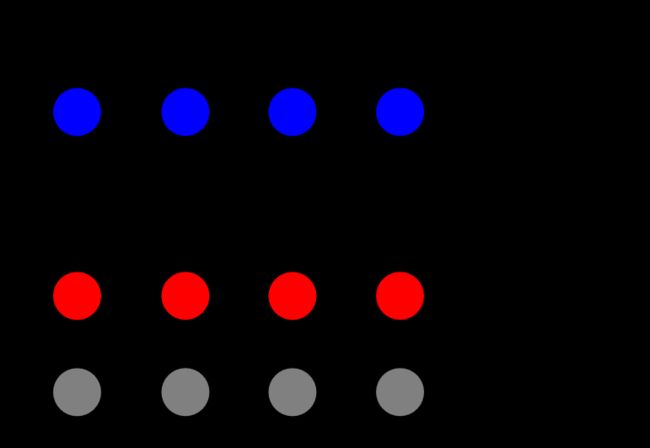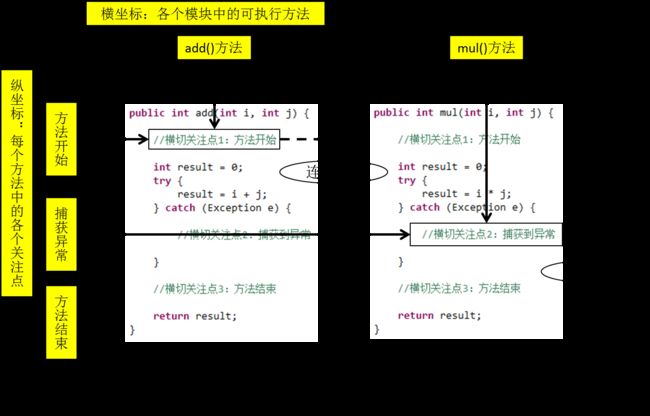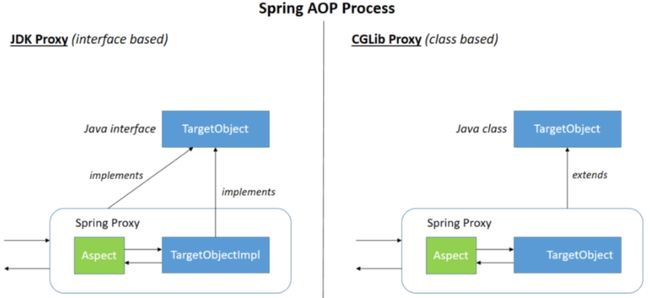Spring系列:基于Spring-AOP和Spring-Aspects实现AOP切面编程
文章目录
-
- 一、概念及相关术语
-
- 概念
- 相关术语
-
-
- ①横切关注点
- ②通知(增强)
- ③切面
- ④目标
- ⑤代理
- ⑥连接点
- ⑦切入点
-
- 作用
- 二、基于注解的AOP
-
- 技术说明
- 准备工作
- 创建切面类并配置
- 各种通知
- 切入点表达式语法
- 重用切入点表达式
- 获取通知的相关信息
- 环绕通知
- 切面的优先级
- 三、基于XML的AOP
-
- 准备工作
- 实现
一、概念及相关术语
概念
AOP(Aspect Oriented Programming)是一种设计思想,是软件设计领域中的面向切面编程,它是面向对象编程的一种补充和完善,它以通过预编译方式和运行期动态代理方式实现,在不修改源代码的情况下,给程序动态统一添加额外功能的一种技术。利用AOP可以对业务逻辑的各个部分进行隔离,从而使得业务逻辑各部分之间的耦合度降低,提高程序的可重用性,同时提高了开发的效率。
相关术语
①横切关注点
分散在每个各个模块中解决同一样的问题,如用户验证、日志管理、事务处理、数据缓存都属于横切关注点。
从每个方法中抽取出来的同一类非核心业务。在同一个项目中,我们可以使用多个横切关注点对相关方法进行多个不同方面的增强。
这个概念不是语法层面的,而是根据附加功能的逻辑上的需要:有十个附加功能,就有十个横切关注点。
②通知(增强)
增强,通俗说,就是你想要增强的功能,比如 安全,事务,日志等。
每一个横切关注点上要做的事情都需要写一个方法来实现,这样的方法就叫通知方法。
- 前置通知:在被代理的目标方法前执行
- 返回通知:在被代理的目标方法成功结束后执行(寿终正寝)
- 异常通知:在被代理的目标方法异常结束后执行(死于非命)
- 后置通知:在被代理的目标方法最终结束后执行(盖棺定论)
- 环绕通知:使用try…catch…finally结构围绕整个被代理的目标方法,包括上面四种通知对应的所有位置
③切面
封装通知方法的类。
④目标
被代理的目标对象。
⑤代理
向目标对象应用通知之后创建的代理对象。
⑥连接点
这也是一个纯逻辑概念,不是语法定义的。
把方法排成一排,每一个横切位置看成x轴方向,把方法从上到下执行的顺序看成y轴,x轴和y轴的交叉点就是连接点。通俗说,就是spring允许你使用通知的地方
⑦切入点
定位连接点的方式。
每个类的方法中都包含多个连接点,所以连接点是类中客观存在的事物(从逻辑上来说)。
如果把连接点看作数据库中的记录,那么切入点就是查询记录的 SQL 语句。
Spring 的 AOP 技术可以通过切入点定位到特定的连接点。通俗说,要实际去增强的方法
切点通过 org.springframework.aop.Pointcut 接口进行描述,它使用类和方法作为连接点的查询条件。
作用
-
简化代码:把方法中固定位置的重复的代码抽取出来,让被抽取的方法更专注于自己的核心功能,提高内聚性。
-
代码增强:把特定的功能封装到切面类中,看哪里有需要,就往上套,被套用了切面逻辑的方法就被切面给增强了。
二、基于注解的AOP
技术说明
- 动态代理分为JDK动态代理和cglib动态代理
- 当目标类有接口的情况使用JDK动态代理和cglib动态代理,没有接口时只能使用cglib动态代理
- JDK动态代理动态生成的代理类会在com.sun.proxy包下,类名为$proxy1,和目标类实现相同的接口
- cglib动态代理动态生成的代理类会和目标在在相同的包下,会继承目标类
- 动态代理(InvocationHandler):JDK原生的实现方式,需要被代理的目标类必须实现接口。因为这个技术要求代理对象和目标对象实现同样的接口(兄弟两个拜把子模式)。
- cglib:通过继承被代理的目标类(认干爹模式)实现代理,所以不需要目标类实现接口。
- AspectJ:是AOP思想的一种实现。本质上是静态代理,将代理逻辑“织入”被代理的目标类编译得到的字节码文件,所以最终效果是动态的。weaver就是织入器。Spring只是借用了AspectJ中的注解
准备工作
①添加依赖
在IOC所需依赖基础上再加入下面依赖即可:
<dependency>
<groupId>org.springframeworkgroupId>
<artifactId>spring-contextartifactId>
<version>6.1.1version>
dependency>
<dependency>
<groupId>org.springframeworkgroupId>
<artifactId>spring-aopartifactId>
<version>6.1.1version>
dependency>
<dependency>
<groupId>org.springframeworkgroupId>
<artifactId>spring-aspectsartifactId>
<version>6.1.1version>
dependency>
<dependency>
<groupId>org.junit.jupitergroupId>
<artifactId>junit-jupiter-apiartifactId>
<version>5.9.3version>
dependency>
<dependency>
<groupId>org.apache.logging.log4jgroupId>
<artifactId>log4j-coreartifactId>
<version>2.20.0version>
dependency>
<dependency>
<groupId>org.apache.logging.log4jgroupId>
<artifactId>log4j-slf4j2-implartifactId>
<version>2.20.0version>
dependency>
②准备被代理的目标资源
接口:
package com.mcode.annotationaop;
/**
* ClassName: Calculator
* Package: com.mcode.annotationaop
* Description:
*
* @Author: robin
* @Version: v1.0
*/
public interface Calculator {
int add(int i, int j);
int sub(int i, int j);
int mul(int i, int j);
int div(int i, int j);
}
实现类:
package com.mcode.annotationaop;
import org.springframework.stereotype.Component;
/**
* ClassName: CalculatorImpl
* Package: com.mcode.annotationaop
* Description:
*
* @Author: robin
* @Version: v1.0
*/
@Component
public class CalculatorImpl implements Calculator {
@Override
public int add(int i, int j) {
int result = i + j;
System.out.println("方法内部 result = " + result);
//为了测试,模拟异常出现
//int a = 1/0;
return result;
}
@Override
public int sub(int i, int j) {
int result = i - j;
System.out.println("方法内部 result = " + result);
return result;
}
@Override
public int mul(int i, int j) {
int result = i * j;
System.out.println("方法内部 result = " + result);
return result;
}
@Override
public int div(int i, int j) {
int result = i / j;
System.out.println("方法内部 result = " + result);
return result;
}
}
创建切面类并配置
package com.mcode.annotationaop;
import org.aspectj.lang.JoinPoint;
import org.aspectj.lang.ProceedingJoinPoint;
import org.aspectj.lang.annotation.*;
import org.springframework.stereotype.Component;
import java.util.Arrays;
/**
* ClassName: LogAspect
* Package: com.mcode.annotationaop
* Description: 切面类
*
* @Author: robin
* @Version: v1.0
*/
@Aspect //切面类
@Component //ioc容器
public class LogAspect {
//设置切入点和通知类型
//切入点表达式: execution(访问修饰符 增强方法返回类型 增强方法所在类全路径.方法名称(方法参数))
//通知类型:
// 前置 @Before(value="切入点表达式配置切入点")
//@Before(value = "execution(* com.mcode.annotationaop.CalculatorImpl.*(..))")
@Before("execution(public int com.mcode.annotationaop.CalculatorImpl.*(..))")
public void beforeMethod(JoinPoint joinPoint) {
String methodName = joinPoint.getSignature().getName();
Object[] args = joinPoint.getArgs();
System.out.println("Logger-->前置通知,方法名称:" + methodName + ",参数:" + Arrays.toString(args));
}
// 后置 @After()
@After("execution(* com.mcode.annotationaop.CalculatorImpl.*(..))")
public void afterMethod(JoinPoint joinPoint) {
String methodName = joinPoint.getSignature().getName();
Object[] args = joinPoint.getArgs();
System.out.println("Logger-->后置通知,方法名称:" + methodName + ",参数:" + Arrays.toString(args));
}
// 返回 @AfterReturning
@AfterReturning(value = "execution(* com.mcode.annotationaop.CalculatorImpl.*(..))",
returning = "result")
public void afterReturningMethod(JoinPoint joinPoint, Object result) {
String methodName = joinPoint.getSignature().getName();
System.out.println("Logger-->返回通知,方法名称:" + methodName + ",返回结果:" + result);
}
// 异常 @AfterThrowing 获取到目标方法异常信息
//目标方法出现异常,这个通知执行
@AfterThrowing(value = "execution(* com.mcode.annotationaop.CalculatorImpl.*(..))", throwing =
"ex")
public void afterThrowingMethod(JoinPoint joinPoint, Throwable ex) {
String methodName = joinPoint.getSignature().getName();
System.out.println("Logger-->异常通知,方法名称:" + methodName + ",异常信息:" + ex);
}
// 环绕 @Around()
@Around("execution(* com.mcode.annotationaop.CalculatorImpl.*(..))")
public Object aroundMethod(ProceedingJoinPoint joinPoint) {
String methodName = joinPoint.getSignature().getName();
Object[] args = joinPoint.getArgs();
String argString = Arrays.toString(args);
Object result = null;
try {
System.out.println("环绕通知-->目标对象方法执行之前");
//调用目标方法
result = joinPoint.proceed();
System.out.println("环绕通知-->目标对象方法返回值之后");
} catch (Throwable e) {
e.printStackTrace();
System.out.println("环绕通知-->目标对象方法出现异常时");
} finally {
System.out.println("环绕通知-->目标对象方法执行完毕");
}
return result;
}
}
添加Spring配置类
package com.mcode.annotationaop;
import org.springframework.context.annotation.ComponentScan;
import org.springframework.context.annotation.Configuration;
import org.springframework.context.annotation.EnableAspectJAutoProxy;
/**
* ClassName: SpringConfig
* Package: com.mcode.annotationaop
* Description:
* 基于注解的AOP的实现:
* 1、将目标对象和切面交给IOC容器管理(注解+扫描)
* 2、开启AspectJ的自动代理,为目标对象自动生成代理
* 3、将切面类通过注解@Aspect标识
* @Author: robin
* @Version: v1.0
*/
@Configuration
@ComponentScan("com.mcode.annotationaop")
@EnableAspectJAutoProxy //开启AspectJ的自动代理,为目标对象自动生成代理
public class SpringConfig {
}
执行测试:
package com.mcode.annotationaop;
import org.junit.jupiter.api.Test;
import org.springframework.context.annotation.AnnotationConfigApplicationContext;
/**
* ClassName: TestAop
* Package: com.mcode.annotationaop
* Description:
*
* @Author: robin
* @Version: v1.0
*/
public class TestAop {
@Test
public void testAdd(){
AnnotationConfigApplicationContext context = new AnnotationConfigApplicationContext(SpringConfig.class);
Calculator calculator = context.getBean(Calculator.class);
calculator.add(1,2);
}
}
执行结果:
各种通知
- 前置通知:使用@Before注解标识,在被代理的目标方法前执行
- 返回通知:使用@AfterReturning注解标识,在被代理的目标方法成功结束后执行(寿终正寝)
- 异常通知:使用@AfterThrowing注解标识,在被代理的目标方法异常结束后执行(死于非命)
- 后置通知:使用@After注解标识,在被代理的目标方法最终结束后执行(盖棺定论)
- 环绕通知:使用@Around注解标识,使用try…catch…finally结构围绕整个被代理的目标方法,包括上面四种通知对应的所有位置
各种通知的执行顺序:
- Spring版本5.3.x以前:
- 前置通知
- 目标操作
- 后置通知
- 返回通知或异常通知
- Spring版本5.3.x以后:
- 前置通知
- 目标操作
- 返回通知或异常通知
- 后置通知
切入点表达式语法
①作用
②语法细节
-
用*号代替“权限修饰符”和“返回值”部分表示“权限修饰符”和“返回值”不限
-
在包名的部分,一个“*”号只能代表包的层次结构中的一层,表示这一层是任意的。
- 例如:*.Hello匹配com.Hello,不匹配com.atguigu.Hello
-
在包名的部分,使用“*…”表示包名任意、包的层次深度任意
-
在类名的部分,类名部分整体用*号代替,表示类名任意
-
在类名的部分,可以使用*号代替类名的一部分
- 例如:*Service匹配所有名称以Service结尾的类或接口
-
在方法名部分,可以使用*号表示方法名任意
-
在方法名部分,可以使用*号代替方法名的一部分
- 例如:*Operation匹配所有方法名以Operation结尾的方法
-
在方法参数列表部分,使用(…)表示参数列表任意
-
在方法参数列表部分,使用(int,…)表示参数列表以一个int类型的参数开头
-
在方法参数列表部分,基本数据类型和对应的包装类型是不一样的
- 切入点表达式中使用 int 和实际方法中 Integer 是不匹配的
-
在方法返回值部分,如果想要明确指定一个返回值类型,那么必须同时写明权限修饰符
- 例如:execution(public int …Service.(…, int)) 正确
例如:execution( int *…Service.(…, int)) 错误
- 例如:execution(public int …Service.(…, int)) 正确
重用切入点表达式
①声明
@Pointcut("execution(* com.mcode.annotationaop.CalculatorImpl.*(..))")
public void pointCut(){}
②在同一个切面中使用
@Before("pointCut()")
public void beforeMethod(JoinPoint joinPoint){
String methodName = joinPoint.getSignature().getName();
String args = Arrays.toString(joinPoint.getArgs());
System.out.println("Logger-->前置通知,方法名:"+methodName+",参数:"+args);
}
③在不同切面中使用
@Before("com.mcode.annotationaop.LogAspect.pointCut()")
public void beforeMethod(JoinPoint joinPoint){
String methodName = joinPoint.getSignature().getName();
String args = Arrays.toString(joinPoint.getArgs());
System.out.println("Logger-->前置通知,方法名:"+methodName+",参数:"+args);
}
获取通知的相关信息
①获取连接点信息
获取连接点信息可以在通知方法的参数位置设置JoinPoint类型的形参
@Before("execution(public int com.mcode.annotationaop.CalculatorImpl.*(..))")
public void beforeMethod(JoinPoint joinPoint) {
//获取连接点的签名信息
String methodName = joinPoint.getSignature().getName();
//获取目标方法到的实参信息
Object[] args = joinPoint.getArgs();
System.out.println("Logger-->前置通知,方法名称:" + methodName + ",参数:" + Arrays.toString(args));
}
②获取目标方法的返回值
@AfterReturning中的属性returning,用来将通知方法的某个形参,接收目标方法的返回值
// 返回 @AfterReturning
@AfterReturning(value = "execution(* com.mcode.annotationaop.CalculatorImpl.*(..))",returning = "result")
public void afterReturningMethod(JoinPoint joinPoint, Object result) {
String methodName = joinPoint.getSignature().getName();
System.out.println("Logger-->返回通知,方法名称:" + methodName + ",返回结果:" + result);
}
③获取目标方法的异常
@AfterThrowing中的属性throwing,用来将通知方法的某个形参,接收目标方法的异常
@AfterThrowing(value = "execution(* com.mcode.annotationaop.CalculatorImpl.*(..))", throwing ="ex")
public void afterThrowingMethod(JoinPoint joinPoint, Throwable ex) {
String methodName = joinPoint.getSignature().getName();
System.out.println("Logger-->异常通知,方法名称:" + methodName + ",异常信息:" + ex);
}
环绕通知
@Around("execution(* com.mcode.annotationaop.CalculatorImpl.*(..))")
public Object aroundMethod(ProceedingJoinPoint joinPoint) {
String methodName = joinPoint.getSignature().getName();
Object[] args = joinPoint.getArgs();
String argString = Arrays.toString(args);
Object result = null;
try {
System.out.println("环绕通知-->目标对象方法执行之前");
//目标方法的执行,目标方法的返回值一定要返回给外界调用者,否则会报错
result = joinPoint.proceed();
System.out.println("环绕通知-->目标对象方法返回值之后");
} catch (Throwable e) {
e.printStackTrace();
System.out.println("环绕通知-->目标对象方法出现异常时");
} finally {
System.out.println("环绕通知-->目标对象方法执行完毕");
}
return result;
}
切面的优先级
相同目标方法上同时存在多个切面时,切面的优先级控制切面的内外嵌套顺序。
- 优先级高的切面:外面
- 优先级低的切面:里面
使用@Order注解可以控制切面的优先级:
- @Order(较小的数):优先级高
- @Order(较大的数):优先级低
@Order(1) //优先级
public class LogAspect {
}
三、基于XML的AOP
准备工作
在Spring的配置文件中配置:
<beans xmlns="http://www.springframework.org/schema/beans"
xmlns:xsi="http://www.w3.org/2001/XMLSchema-instance"
xmlns:context="http://www.springframework.org/schema/context"
xmlns:aop="http://www.springframework.org/schema/aop"
xsi:schemaLocation="http://www.springframework.org/schema/beans http://www.springframework.org/schema/beans/spring-beans.xsd http://www.springframework.org/schema/context https://www.springframework.org/schema/context/spring-context.xsd http://www.springframework.org/schema/aop https://www.springframework.org/schema/aop/spring-aop.xsd">
<context:component-scan base-package="com.mcode.xmlaop"/>
<aop:config>
<aop:aspect ref="logAspect">
<aop:pointcut id="pointcut"
expression="execution(* com.mcode.xmlaop.CalculatorImpl.*(..))"/>
<aop:before method="beforeMethod"
pointcut="execution(public int com.mcode.xmlaop.CalculatorImpl.*(..))"/>
<aop:after method="afterMethod" pointcut-ref="pointcut"/>
<aop:after-returning method="afterReturningMethod" pointcut-ref="pointcut" returning="result"/>
<aop:after-throwing method="afterThrowingMethod" pointcut-ref="pointcut" throwing="ex"/>
<aop:around method="aroundMethod" pointcut-ref="pointcut"/>
aop:aspect>
aop:config>
beans>
实现
创建切面类并配置:
package com.mcode.xmlaop;
import org.aspectj.lang.JoinPoint;
import org.aspectj.lang.ProceedingJoinPoint;
import org.aspectj.lang.annotation.*;
import org.springframework.stereotype.Component;
import java.util.Arrays;
/**
* ClassName: LogAspect
* Package: com.mcode.xmlaop
* Description: 切面类
*
* @Author: robin
* @Version: v1.0
*/
@Component //ioc容器
public class LogAspect {
// 前置
public void beforeMethod(JoinPoint joinPoint) {
//获取连接点的签名信息
String methodName = joinPoint.getSignature().getName();
//获取目标方法到的实参信息
Object[] args = joinPoint.getArgs();
System.out.println("Logger-->前置通知,方法名称:" + methodName + ",参数:" + Arrays.toString(args));
}
// 后置
public void afterMethod(JoinPoint joinPoint) {
//获取连接点的签名信息
String methodName = joinPoint.getSignature().getName();
//获取目标方法到的实参信息
Object[] args = joinPoint.getArgs();
System.out.println("Logger-->后置通知,方法名称:" + methodName + ",参数:" + Arrays.toString(args));
}
// 返回
public void afterReturningMethod(JoinPoint joinPoint, Object result) {
String methodName = joinPoint.getSignature().getName();
System.out.println("Logger-->返回通知,方法名称:" + methodName + ",返回结果:" + result);
}
// 异常
public void afterThrowingMethod(JoinPoint joinPoint, Throwable ex) {
String methodName = joinPoint.getSignature().getName();
System.out.println("Logger-->异常通知,方法名称:" + methodName + ",异常信息:" + ex);
}
// 环绕
public Object aroundMethod(ProceedingJoinPoint joinPoint) {
String methodName = joinPoint.getSignature().getName();
Object[] args = joinPoint.getArgs();
String argString = Arrays.toString(args);
Object result = null;
try {
System.out.println("环绕通知-->目标对象方法执行之前");
//目标方法的执行,目标方法的返回值一定要返回给外界调用者,否则会报错
result = joinPoint.proceed();
System.out.println("环绕通知-->目标对象方法返回值之后");
} catch (Throwable e) {
e.printStackTrace();
System.out.println("环绕通知-->目标对象方法出现异常时");
} finally {
System.out.println("环绕通知-->目标对象方法执行完毕");
}
return result;
}
}
执行测试:
package com.mcode.xmlaop;
import com.mcode.annotationaop.Calculator;
import org.junit.jupiter.api.Test;
import org.springframework.context.support.ClassPathXmlApplicationContext;
/**
* ClassName: TestAop
* Package: com.mcode.annotationaop
* Description:
*
* @Author: robin
* @Version: v1.0
*/
public class TestAop {
@Test
public void testAdd(){
ClassPathXmlApplicationContext context =
new ClassPathXmlApplicationContext("beans.xml");
Calculator calculator = context.getBean(Calculator.class);
calculator.add(1,2);
}
}
执行结果:










